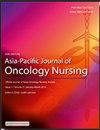Development, validation, and clinical utility of risk prediction models for cancer-associated venous thromboembolism: A retrospective and prospective cohort study
IF 2.8
3区 医学
Q1 NURSING
引用次数: 0
Abstract
Objectives
This study aims to develop cancer-associated venous thromboembolism (CA-VTE) risk prediction models using survival machine learning (ML) algorithms.
Methods
This study employed a double-cohort study design (retrospective and prospective). The retrospective cohort (n = 1036) was used as training set (70.0%, n = 725) and internal validation set (30.0%, n = 311); while the prospective cohort (n = 321) was used as external validation set. Seven survival ML algorithms, including COX regression, classification, regression and survival tree, random survival forest, gradient boosting survival machine tree, extreme gradient boosting survival tree, survival support vector analysis, and survival artificial neural network, were applied to train CA-VTE models.
Results
Univariate analysis and LASSO-COX regression both selected five predictors: age, previous VTE history, ICU/CCU, CCI, and D-dimer. The seven survival ML models (C-index: 0.709–0.760; Brier Score: 0.212–0.243) all outperformed Khorana Score (C-index: 0.632; Brier Score: 0.260) in external validation set. Among all models, the COX_DD model (COX regression + D-dimer) performed best. However, ML models and Khorana Score predicted CA-VTE risk on 7 days of hospitalization with an increase in Brier Score 0.25, showing poor calibration.
Conclusions
In this study, the CA-VTE risk prediction models developed in seven survival ML algorithms outperformed Khorana Score. Combining with D-dimer can improve model performance. Applying the nomogram based on the optimal COX_DD model allows oncology nurse to reassess CA-VTE risk once a week. The prediction models developed using survival ML algorithms in this study may contribute to the dynamic and accurate risk assessment of CA-VTE for cancer survivors.
癌症相关静脉血栓栓塞风险预测模型的发展、验证和临床应用:一项回顾性和前瞻性队列研究
本研究旨在利用生存机器学习(ML)算法建立癌症相关静脉血栓栓塞(CA-VTE)风险预测模型。方法采用双队列研究设计(回顾性和前瞻性)。采用回顾性队列(n = 1036)作为训练集(70.0%,n = 725)和内部验证集(30.0%,n = 311);采用前瞻性队列(n = 321)作为外部验证集。采用COX回归、分类、回归与生存树、随机生存森林、梯度增强生存机树、极端梯度增强生存树、生存支持向量分析、生存人工神经网络等7种生存ML算法对CA-VTE模型进行训练。结果单因素分析和LASSO-COX回归均选择了年龄、静脉血栓栓塞史、ICU/CCU、CCI和d -二聚体5个预测因素。7种生存期ML模型(C-index: 0.709-0.760;Brier Score: 0.212-0.243)均优于Khorana Score (C-index: 0.632;外部验证集Brier评分:0.260)。在所有模型中,COX_DD模型(COX回归+ d -二聚体)表现最好。然而,ML模型和Khorana评分预测住院≥7天CA-VTE风险,Brier评分升高≥0.25,显示校准不良。结论在本研究中,7种生存ML算法建立的CA-VTE风险预测模型优于Khorana评分。与d -二聚体结合可提高模型性能。应用基于最佳COX_DD模型的nomogram允许肿瘤科护士每周重新评估一次CA-VTE风险。本研究中使用生存ML算法建立的预测模型可能有助于对癌症幸存者的CA-VTE进行动态和准确的风险评估。
本文章由计算机程序翻译,如有差异,请以英文原文为准。
求助全文
约1分钟内获得全文
求助全文
来源期刊

Asia-Pacific Journal of Oncology Nursing
Multiple-
CiteScore
2.80
自引率
11.10%
发文量
136
审稿时长
31 days
 求助内容:
求助内容: 应助结果提醒方式:
应助结果提醒方式:


